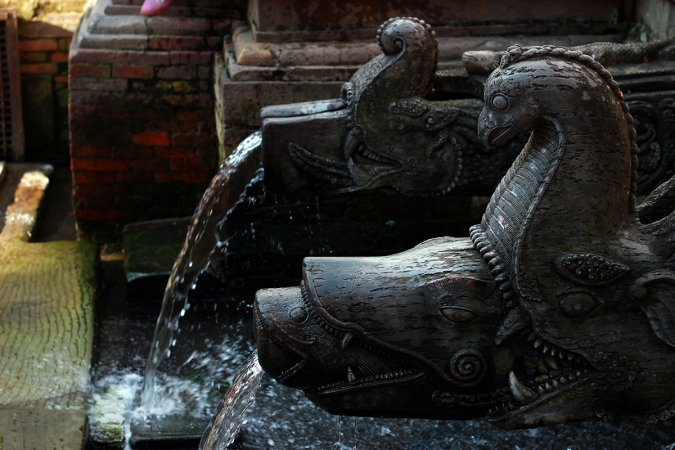By Sanyukta Shrestha
Published in DREAMS Magazine, August 2015
I was born to a household opposite a big marshy pond. When I was about six, local people dug it up to reveal a beautiful water conduit with hundreds of ancient sculptures lying around. I then realised why the town was called Naxal-DhungeDhara.
As I turned twenty, a pond next to Thamel, some 2 Km west from Naxal, was dug up to reveal another dhungedhara in working condition and accompanied by a number of Lichhavi period artefacts including a 397 years old inscription! I realised that my neighbourhood could be just one such example and a huge number of other dhungedharas could be well under the ponds or even the ground level waiting to be unearthed.
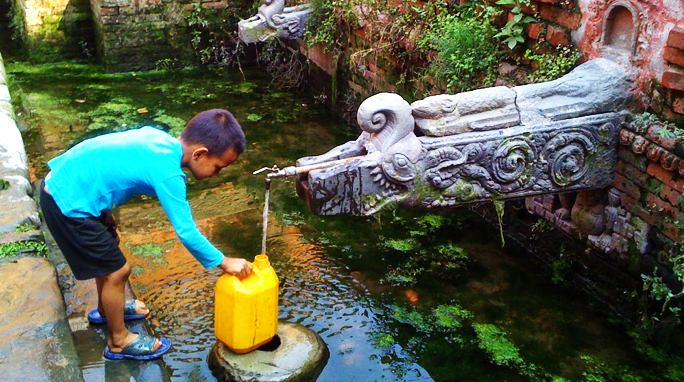 (Photo: Naxal-DhungeDhara, Kathmandu. Sanyukta Shrestha, 2013)
(Photo: Naxal-DhungeDhara, Kathmandu. Sanyukta Shrestha, 2013)
A more classic case being the excavation of HandiGaun in 1989 AD, which unearthed a dhungedhara dated 726 AD. Furthermore, the meaning of “BhotaHiti” would have lost in oblivion had there not been discovered four water conduits with an inscription dated 596 AD, according to historian Shanker Man Rajvamshi.
Furthermore, wherever the settlement of Newars expanded outside of Kathmandu, along with their festivals and food, they took their architectural expertise with them. That is the sole reason why dhungedharas are not a rare sight as far away as TeenDhara of Gorkha.
Technology & Challenges
Rainwater is absorbed from the ground to form natural sources that provide water to dhungedharas. In order not to depend entirely on rainwater, channels called rajkulo were built to supply water from rivers to the sources of dhungedhara. Also, several ponds were built around the dhungedhara so that water can seep through the land around it.
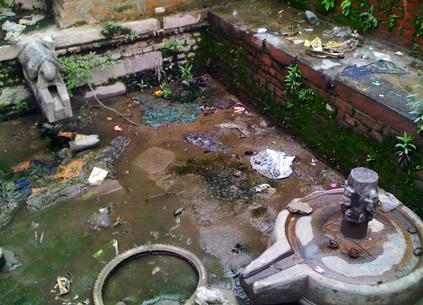
(Photo: The present state of GairiDhara, Kathmandu. Sanyukta Shrestha, 2013)
Speciality
The speciality of dhungedharas is in their use of gravity in channelling the water; systematic flow-control to regulate the amount, advanced drainage to avoid blockages, water-purification and waterproofing.
While modern basement constructions struggle to keep it waterproof, we can see implementation of advanced waterproofing technology in dhungedharas, – it is only the pout that delivers water without any leakage below ground level. How Nepali architecture was as advanced by the 5th century is unexplainable today!
The Architecture
Besides being primarily stone-built, the use of gold is common in royal versions like the ones found inside the palaces of Kathmandu, Patan and Bhaktapur, alongside some public constructions like SunDhara located in each of the above three towns; an interesting exception being Dhalko‘s wooden dhara.
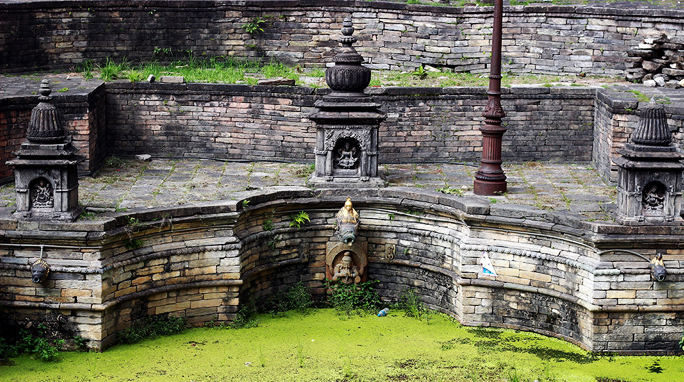
(Photo: Sundhara, Kathmandu. Bikkil Sthapit, 2014)
The basic architecture of a dhungedhara includes HitiMangah or the main spout structure, and HitiGah or the conduit’s basin. The HitiMangah further forms the most common trinity with a cult image above and a relief of Bhagirath below it. This fundamental combination is often housed within a sunken courtyard perhaps to facilitate the flow of water utilising gravitational pull. Often a paati, or resting platform, can be seen outside many dhungedhara complexes, to be used by travellers.
While common number of spouts per dhungedhara are either one or three, extension to four or five are also found. With one each to sample, Godavari‘s NauDhara, Balaju‘s BaiseyDhara and Muktinath‘s Ek-Saye-Aath-Dhara include nine, twenty-two, and a hundred and eight spouts respectively.
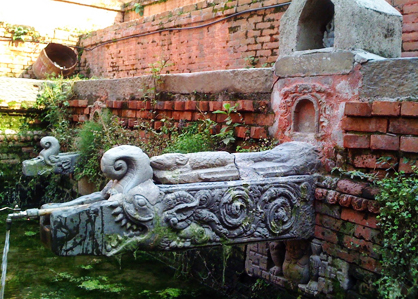
(Photo: Bhagirath as seen under the spout of Naxal-DhungeDhara. Sanyukta Shrestha, 2013)
As a beautiful blend of technology and art, dhungedharas are unique to Nepal as its spouts flank the iconic mythical character frequenting in Nepalese art, – the makara, carrier of Hindu goddess of water, Ganga. The usual presence of Bhagirath underneath these spouts is justified, as he is believed to be the one who brought Ganga from the heaven to earth.
According to a research by Riddhi Pradhan, other animals that are featured in the spouts are cow, goat, elephant, tiger and cock. Two such examples I could trace are the gomukhi (cow-headed) spouts found in Swayambhu‘s Bhuye Kheo and the NarayanHiti of Kathmandu.
History
While the earliest mention of dhungedhara is in an inscription dated 550 AD found in HadiGaun, the oldest among existing dhungedharas is the MangaHiti of Patan built in 570 AD. This unparalleled Nepali technology continued for as long as fifteen centuries, with some 300 more successful constructions between Kathmandu, Patan and Bhaktapur, until the last and the largest known among these, Kathmandu‘s SunDhara, was built by Queen Lalit Tripura Sundari Devi in 1828 AD.
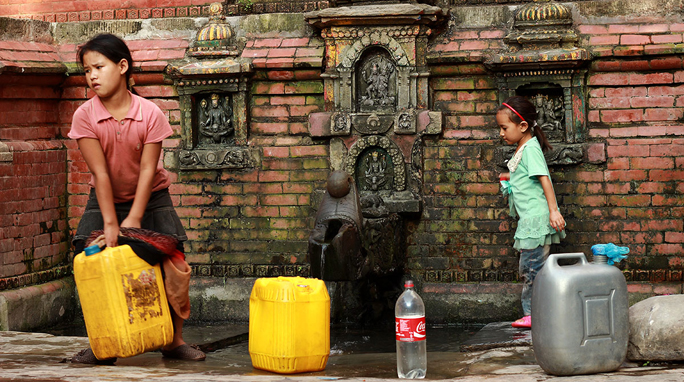
(Photo: MaruHiti, Kathmandu. Bikkil Sthapit, 2014)
While the most spoken language in Kathmandu valley kept changing over centuries, from early Lichhavi period through the Malla period, traditional water conduits were firstly called ‘Kirti’ (merit), then ‘Pranali’ (method), then ‘LwoHiti’ (stone tap) and more recently ‘dhungedhara’. As it stands literally, for early Lichhavi era, these conduits were a medium of earning religious and social merit; late Lichhavi period was when its construction became more systematic, and during the Malla period, it was taken to a completely next level of art and technology.
Religious Connection
The water from many dhungedharas has religious significance. While water from the left spout of Patan‘s MangaHiti initiates the character of Hiranyakashipu in Kartik Naach, that from its right spout is needed for the worship of Krishna temple. Likewise, Bhaktapur offers water from its SunDhara to goddess Taleju and serves those joining ShivaRatri from BhimDyoHiti. Also notable is the fact that major pilgrimage sites like Godavari, MataTirtha and Balaju have dhungedharas installed within their premises.
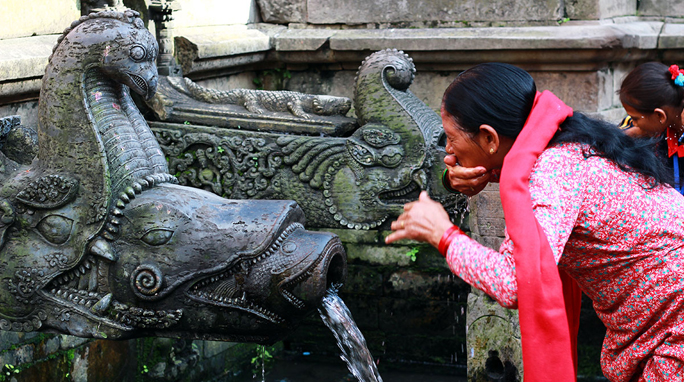
(Photo: MangaHiti, Patan. Bikkil Sthapit, 2014)
Social Beliefs and Myths
As a child, I could never understand this magic but my mum always asserted that dhungedhara’s water is cold in the summer and warm in the winter. She did prove her point by making me go and have a bath but something I failed to attest in the absence of geological surveys, was many people believing dhungedhara’s water to come with medicinal bonus; people drink water from Kathmandu‘s Sundhara as a cure for arthritis, and Bhaktapur‘s GahHiti is supposed to cure goitre.
Being a part of our social life for such a long time, dhungedharas share a significant space in Kathmandu‘s social belief system, whether it is our knowledge, superstition or even myth. About 700m west from Naxal-DhungeDhara, is the legendary NarayanHiti, – a dhungedhara that gives its name to the historic Royal Palace of the last Shah rulers of Nepal. Its spout is perhaps the most mythical of all, bearing a makara turning its head backward!
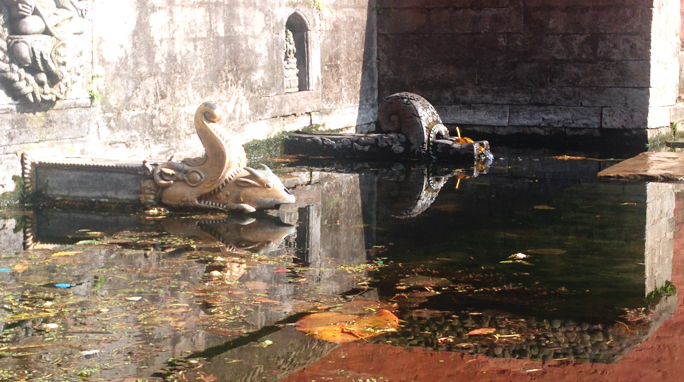
(Photo: NarayanHiti, Kathmandu. Prawesh Rajkarnikar, 2015)
I grew up listening to this local story:
Having to sacrifice a flawless person in order to run the NarayanHiti spout that had stopped working, King RaghavDev disguised himself after asking his son ManDev to severe this person in disguise. When ManDev was draining his father’s blood from his sword at the spout, the makara on the spouts couldn’t bear it and turned their heads backward.
“That’s why the trunk of NarayanHiti‘s makara is seen reversed, the only one of its kind in Nepal”, my mum would always whisper at the end, even for the hundredth time of re-telling this story.
As a grown up, her story really confused me how history actually repeated itself in the form of 2001 Royal massacre at NarayanHiti Palace just across the road. To me, the so-called ‘reversed’ trunk looks more like an accentuation making space for a smaller cow’s head protruding out of it.
The Future
When I was twenty-five, I moved to the metropolis of London and the everyday sight of dhungedhara would then make up a big part of my overall longing. Carefree kids diving in cold water to escape the mid-day summer heat, the common place for local ladies to have a bath and for the dhobi community to make best use of the courtyard on a business-as-normal day, – all seemed an idea far from the comforts of the first world.
Not that I would not meet Nepalis over here but their idea of development would sound as big as it could get, – engineers planning to build metro trains across the heart of Kathmandu, or IT experts suggesting a load-shedding Nepal to go for e-voting.
After solid two decades of the introduction of piped tap water in Kathmandu, it has fallen flat in catering the urban demand, and the forever setting back Melamchi project has had no other impact than political parties wooing their voters. We have by far lost the indigenous knowledge of all our engineering feats including dhungedharas.
Dhungedharas outside our houses have been running for as long as 1500 years but in the last 35 years of engineering education in Nepal, we have not found it necessary to revive our traditional water conduits despite the valley’s water crisis. This is also how a country loses its identity, – by forgetting its native technologies; pushing it further away from economic independence. It’s not just about heritage, it’s about failing to realise where our strength lies before even thinking of global competition.
Acknowledgements:
Prof. Sudarshan Raj Tiwari, Culture Expert Ganesh Ram Lachhi, Historian Shanker Man Rajvamshi, Engineer Prayag Raj Joshi, Researcher Riddhi Pradhan, SanuMaiya Shrestha, Documentarian Alok Siddhi Tuladhar, Artist Udaya Charan Shrestha.
Additional Researcher:
Reetu Joshi
Photographers:
Bikkil Sthapit, Sanyukta Shrestha, Prawesh Rajkarnikar.














